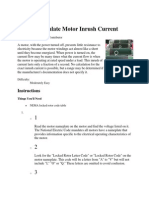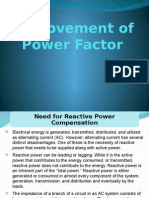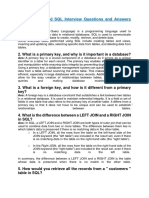How To Calculate Locked Rotor Current (IL) From Nameplate Data
How To Calculate Locked Rotor Current (IL) From Nameplate Data
Uploaded by
Deanna MorganCopyright:
Available Formats
How To Calculate Locked Rotor Current (IL) From Nameplate Data
How To Calculate Locked Rotor Current (IL) From Nameplate Data
Uploaded by
Deanna MorganOriginal Description:
Original Title
Copyright
Available Formats
Share this document
Did you find this document useful?
Is this content inappropriate?
Copyright:
Available Formats
How To Calculate Locked Rotor Current (IL) From Nameplate Data
How To Calculate Locked Rotor Current (IL) From Nameplate Data
Uploaded by
Deanna MorganCopyright:
Available Formats
How to calculate Locked Rotor Current (IL) From Nameplate Data
The lock rotor amps is the current draw of the motor when the motor is switched on and before the rotor starts to turn. This is the stator current but it is called lock rotor current for 2 reasons. (1) The measured current is at a time (0 sec) ie when the rotor is at standstill,thus the rotor is considered "LOCKED" and thus the term LOCK ROTOR AMPS. (2) You can mechanically strap down the rotor (LOCK ROTOR),press the start button and measure the stator current. This lock rotor amps is the highest current draw of the motor because when the rotor is locked impedance is the lowest. Item 2 above You can use a clip on to measure the Lock rotor amps. Another method for measuring lock rotor amps is by using a storage oscilloscope and a passive resistor. Regards
3-Phase:
Single phase:
See: KVA/HP Chart EXAMPLE: Motor nameplate indicates 10 HP, 3 Phase, 460 Volts, Code F. 577 x 10 x (5.6 or 6.29) IL = 460 IL = 70.25 or 78.9 Amperes (possible range)
Effect Of Line Voltage On Locked Rotor Current (IL) (Approx.)
ELINE IL @ ELINE = IL @ EN/P x EN/P
Code A B C D E
KVA/HP 0-3.14 3.15-3.54 3.55-3.99 4.0 -4.49 4.5 -4.99
Code F G H I K
KVA/HP 5.0 -5.59 5.6 -6.29 6.3 -7.09 7.1 -7.99 8.0 -8.99
Code L M N P R
KVA/HP 9.0-9.99 10.0-11.19 11.2-12.49 12.5-13.99 14.0-15.99
Code S T U V
KVA/HP 16.0-17.99 18.0-19.99 20.0-22.39 22.4 & Up
KVA / HP Chart
http://www.ehow.com/how_7791777_calculate-motor-inrush-current.html
How to Calculate Motor Inrush Current
A motor, with the power turned off, presents little resistance to electricity because the motor windings act almost like a short until they become energized. When power is turned on, the current flow may be many times what the current flow is when the motor is operating at rated speed under a load. This inrush of current lasts only a fraction of a second. No calculation for the exact inrush current is possible, but a range may be determined if the manufacturer's documentation does not specify it. Instructions
1. Read the motor nameplate on the motor and find the voltage listed on it. The National Electric Code mandates all motors have a nameplate that provides information specific to the electrical operating characteristics of the motor. 2. Look for the "Locked Rotor Letter Code" or "Locked Rotor Code" on the motor nameplate. This code will be a letter from "A" to "V" but will not include "I," "O" or "Q." These letters are omitted to avoid confusion. 3. Consult the NEMA Locked Rotor Code Table and find the letter code on it. Follow the letter code row to the right and find the range given. The range is given in thousands of Volt-Amps, or kilowatts. 4. Multiply each number in the range by 1,000. Divide each result by the motor voltage found on the nameplate. The resulting range is the inrush current range. For example: A 3.5-horsepower, three-phase motor nameplate lists the motor voltage as 230 volts and the locked rotor code is "K." The range given on the table is 8.0 to 8.99 KVA. Multiplying by 1,000, the range becomes 8,000 to 8,990 VA. Dividing by the motor voltage of 230 volts gives the inrush current range as 34.8 amps to 39.1 amps.
Tips & Warnings
The inrush current is only momentary and if the circuit breaker is sized properly, it will not trip in the fraction of second the current spikes. As the motor windings become energized, they present resistance to the flow of current and the current begins to drop. As the motor comes up to full
speed, the current level will be at the level specified on the motor nameplate as the full-load current.
The voltage is important to determining inrush current. If the motor nameplate lists multiple voltages, the voltage being used must be determined. An easy place to measure this is at the motor disconnect. The type of voltage determines how the measurement is made. Measure three-phase current between two hot terminals and double it. Split phase current is measured between two hot terminals. Single phase current is measured from the hot terminal to ground
Read more: How to Calculate Motor Inrush Current | eHow.com http://www.ehow.com/how_7791777_calculate-motorinrush-current.html#ixzz2NayKtBP6
http://www.engineeringtoolbox.com/locked-rotor-code-d_917.html
NEMA Code Letter A B C D E F G H J K
KVA/HP with locked rotor 0-3.14 3.15-3.55 3.55-3.99 4.0-4.49 4.5-4.99 5.0-5.59 5.6-6.29 6.3-7.09 7.1-7.99 8.0-8.99
Approximate MidRange Value 1.6 3.3 3.8 4.3 4.7 5.3 5.9 6.7 7.5 8.5
NEMA Code Letter L M N P R S T U V
KVA/HP with locked rotor 9.0-9.99 10.0-11.19 11.2-12.49 12.5-13.99 14.0-15.99 16.0-17.99 18.0-19.99 20.0-22.39 22.4-and up
Approximate MidRange Value 9.5 10.6 11.8 13.2 15.0
You might also like
- Physical Database DesignDocument12 pagesPhysical Database DesignSaltNPepa SaltNPepa100% (1)
- Harmonic Analysis Report - 1Document22 pagesHarmonic Analysis Report - 1Vivek Tiwari50% (2)
- Building A Phase ConverterDocument11 pagesBuilding A Phase ConverterAlvaro Del Cid100% (1)
- Basic Motor Formulas and Calculations PDFDocument11 pagesBasic Motor Formulas and Calculations PDFAditya Shrivastava100% (2)
- Points To Be Consider While Selecting of Vector GroupDocument3 pagesPoints To Be Consider While Selecting of Vector GroupNanban VkyNo ratings yet
- Engine Starting Battery Sizing: Standard ConditionsDocument5 pagesEngine Starting Battery Sizing: Standard Conditionsthomas13130% (1)
- Siemens - Motor SpecificationsDocument50 pagesSiemens - Motor SpecificationsArtifoxNo ratings yet
- Basics of Motor Starting StudyDocument18 pagesBasics of Motor Starting StudyJerome EugeneNo ratings yet
- Iec 60085 - 1984Document10 pagesIec 60085 - 1984patagonik1No ratings yet
- Power System Analysis Ch12solnDocument20 pagesPower System Analysis Ch12solnelessair100% (2)
- Transformer Size Checking - Motor StartingDocument2 pagesTransformer Size Checking - Motor Startingmahesh_sali2003100% (3)
- Electrical Circuit Design For Motors From Philippine Electrical CodeDocument30 pagesElectrical Circuit Design For Motors From Philippine Electrical CodeMichael Bugay100% (3)
- IE3 Motor - Type 2 Co-Ordination - Catalogue - Updated DT 08.04.2017Document52 pagesIE3 Motor - Type 2 Co-Ordination - Catalogue - Updated DT 08.04.2017satwinder singh100% (3)
- Standard Handbook For Electrical EngineersDocument1 pageStandard Handbook For Electrical EngineersVed Prakash Kushwaha0% (2)
- F20BC - CW - 2020 - Biologically InspiredDocument6 pagesF20BC - CW - 2020 - Biologically InspiredNouman RasheedNo ratings yet
- Utility Typical X-R RatioDocument1 pageUtility Typical X-R Ratiokenneth molina50% (2)
- Starting - Large Motor Presentation MAR2016-Rev1Document101 pagesStarting - Large Motor Presentation MAR2016-Rev1royclhorNo ratings yet
- Voltage Drop CalculationsDocument6 pagesVoltage Drop Calculationsjasrock143100% (1)
- Transformer ImpedenceDocument3 pagesTransformer ImpedenceVIKRAM DESAI100% (2)
- Parallel Operation of Synchronous Generators-V3Document70 pagesParallel Operation of Synchronous Generators-V3John Patrick CeldaNo ratings yet
- Sizing Transformers With Large Motor LoadsDocument6 pagesSizing Transformers With Large Motor LoadsRajendra Prasad Shukla50% (2)
- 3.10.1.3 Motor Damage Curve: Electrical Design CalculationDocument12 pages3.10.1.3 Motor Damage Curve: Electrical Design Calculationjimmy_barredoNo ratings yet
- Assignment IDocument4 pagesAssignment Iamith gupta0% (1)
- EASA AC Redesign Manual V.0214-0815 PDFDocument140 pagesEASA AC Redesign Manual V.0214-0815 PDFDon FreemanNo ratings yet
- IEC 60287 Current Capacity of Cables - Rated CurrentDocument1 pageIEC 60287 Current Capacity of Cables - Rated CurrentxsystemNo ratings yet
- IEC 61439 Standard in Electrical Busbar Systems PDFDocument4 pagesIEC 61439 Standard in Electrical Busbar Systems PDFManoj GuptaNo ratings yet
- Motor FormulaDocument5 pagesMotor FormuladrfaizalNo ratings yet
- NGR SelctionDocument18 pagesNGR SelctionpoweranalystNo ratings yet
- Diversity FactorDocument8 pagesDiversity FactorChoirul Mustofa100% (3)
- Electrical Equipment SizingDocument4 pagesElectrical Equipment SizingarshadbayaNo ratings yet
- EIC 09 - Stator Winding Hipot TestingDocument5 pagesEIC 09 - Stator Winding Hipot Testingmanoharig7578No ratings yet
- General Calculations Rev 4Document20 pagesGeneral Calculations Rev 4KARTHIGEYAN.RNo ratings yet
- Line Capability CurveDocument5 pagesLine Capability CurvejavedNo ratings yet
- Power and Distribution Transformers Sizing Calculations 8Document20 pagesPower and Distribution Transformers Sizing Calculations 8hashimelecNo ratings yet
- No Load and Blocked Rotor TestDocument19 pagesNo Load and Blocked Rotor Testsupere100% (5)
- Demand Factor-Diversity Factor-Utilization Factor-Load FactorDocument15 pagesDemand Factor-Diversity Factor-Utilization Factor-Load FactorHansika RajapakshaNo ratings yet
- Calculate Size of Contactor, Fuse, C.B, Over Load Relay of DOL StarterDocument5 pagesCalculate Size of Contactor, Fuse, C.B, Over Load Relay of DOL Startererson19810% (1)
- Under Const Engineering BulletinDocument4 pagesUnder Const Engineering Bulletinsandra mae bonrustroNo ratings yet
- 3 Phase MotorsDocument32 pages3 Phase Motorsdungga10% (1)
- Installation Planning and EstimatingDocument26 pagesInstallation Planning and EstimatingNoob player Free Fire100% (2)
- IEEE Standard ListDocument4 pagesIEEE Standard Listsrshvijay0% (1)
- 3.application of Distribution TransformerDocument76 pages3.application of Distribution TransformerImjusttryingtohelpNo ratings yet
- Generator Design StepsDocument40 pagesGenerator Design Stepsrajfab100% (1)
- 11kVA 3 = 6350.85V 10 MVA 3 (11 kVA) = 525 A 525 (20 %) =105 A 105 A= 6350.85 V (X) 9 ΩDocument3 pages11kVA 3 = 6350.85V 10 MVA 3 (11 kVA) = 525 A 525 (20 %) =105 A 105 A= 6350.85 V (X) 9 ΩNiño John JaymeNo ratings yet
- How To Calculate AC Choke For Mains Supply and DC Choke For DC BusDocument2 pagesHow To Calculate AC Choke For Mains Supply and DC Choke For DC BusNanda Kumar100% (1)
- Generator TestingDocument2 pagesGenerator Testingraghavendran raghu100% (1)
- Lumped Load Editor - Short-Circuit PDFDocument3 pagesLumped Load Editor - Short-Circuit PDFNMulyonoNo ratings yet
- Solved Problems in Electric MotorsDocument6 pagesSolved Problems in Electric Motorssumithra93% (15)
- Upf MythDocument3 pagesUpf MythgurbachansainiNo ratings yet
- Negative Sequence & Zero Sequence Reactance PDFDocument6 pagesNegative Sequence & Zero Sequence Reactance PDFviksoniNo ratings yet
- Induction Machine ReportDocument24 pagesInduction Machine ReportSiddharth NandhanNo ratings yet
- Loop Test and Core RepairDocument6 pagesLoop Test and Core Repairhino_kagu100% (1)
- Cable Size CalculationDocument15 pagesCable Size CalculationRadheshyam RaiNo ratings yet
- How To Calculate Motor Inrush CurrentDocument2 pagesHow To Calculate Motor Inrush CurrentGary Goh100% (2)
- How To Calculate Motor Inrush CurrentDocument2 pagesHow To Calculate Motor Inrush CurrentThirumalNo ratings yet
- How To Calculate Motor Inrush Current 2Document1 pageHow To Calculate Motor Inrush Current 2Gary GohNo ratings yet
- Building A Phase Converter: Includes Self StartingDocument8 pagesBuilding A Phase Converter: Includes Self StartingAngel MontellanoNo ratings yet
- Brake Load Test of Squirel Cage Induction Motor 3 PhaseDocument7 pagesBrake Load Test of Squirel Cage Induction Motor 3 Phasejassisc100% (1)
- Starting Methodologies PDFDocument10 pagesStarting Methodologies PDFReynee Shaira Lamprea MatulacNo ratings yet
- Unit3 EDCDocument13 pagesUnit3 EDCKarthick Sivakumar ChellamuthuNo ratings yet
- KAWALAN MOTOR English VersionDocument59 pagesKAWALAN MOTOR English VersionSuzaini Supingat0% (1)
- Induction Motor StarterDocument5 pagesInduction Motor StarterAnikendu MaitraNo ratings yet
- Epas Modules of InsDocument74 pagesEpas Modules of InsMelba33% (3)
- MIS of Mark Data Nepal PVTDocument8 pagesMIS of Mark Data Nepal PVTNabin PariyarNo ratings yet
- 04 - Improvement of Power FactorDocument29 pages04 - Improvement of Power FactorMohammedAhmadOsamaNo ratings yet
- Giotto Spot 400Document33 pagesGiotto Spot 400zeroinfNo ratings yet
- 6146 PDFDocument14 pages6146 PDFjaydip kapaseNo ratings yet
- Commonly Asked SQL Interview QnADocument26 pagesCommonly Asked SQL Interview QnAavinashkumar143No ratings yet
- Altistart 46: Open Style Soft Start Motor ControllersDocument46 pagesAltistart 46: Open Style Soft Start Motor ControllersHazem Al-kayaliNo ratings yet
- Trinidad Drilling BrochureDocument8 pagesTrinidad Drilling Brochuretictacal100% (1)
- DHTML TutorialDocument7 pagesDHTML TutorialGuntuku BaleswariNo ratings yet
- 2023-11-16 AV OP Médenine N°23-2023Document4 pages2023-11-16 AV OP Médenine N°23-2023haha blablaNo ratings yet
- SINGAPORE The One-North ProjectDocument13 pagesSINGAPORE The One-North ProjectOmerZiaNo ratings yet
- 006 Amlh FR 2023Document20 pages006 Amlh FR 2023sebicapilneanNo ratings yet
- 380910-Eia-0010-01 (2), Temp PDB-02 & 03Document1 page380910-Eia-0010-01 (2), Temp PDB-02 & 03Nikhil SutharNo ratings yet
- EASEC-18 CfA Flyer Nov23Document1 pageEASEC-18 CfA Flyer Nov23pisalNo ratings yet
- Post Disaster Planning and Response Using Geospatial TechnologyDocument15 pagesPost Disaster Planning and Response Using Geospatial TechnologyblackNo ratings yet
- SMP1012X Series - Installation Guide: OverviewDocument4 pagesSMP1012X Series - Installation Guide: OverviewenriquealugovNo ratings yet
- HYpact ProductDocument42 pagesHYpact ProductBogdan Vicol100% (1)
- WEG Wind Turbine Agw 110 2.1 50049460 Brochure English PDFDocument2 pagesWEG Wind Turbine Agw 110 2.1 50049460 Brochure English PDFmacaco28No ratings yet
- lastUIException 63818935367Document5 pageslastUIException 63818935367Alex Vinicius Santos de meloNo ratings yet
- Library Management System PresentationDocument32 pagesLibrary Management System Presentationkaran512900% (1)
- Sony Corp FinalDocument24 pagesSony Corp FinalphknightNo ratings yet
- Fraction To Decimal and MM TableDocument3 pagesFraction To Decimal and MM TableEdem Tamakloe100% (1)
- iOS Security Exam - EuDocument6 pagesiOS Security Exam - EukehicawNo ratings yet
- AWA June 07 - June 11 (Wins)Document3 pagesAWA June 07 - June 11 (Wins)Winston CelestialNo ratings yet
- Railway CablesDocument251 pagesRailway Cablesdcf67my100% (1)
- VRV General Catalogue - Cooling Only 50Hz - APCVDT1613 (Low Res)Document96 pagesVRV General Catalogue - Cooling Only 50Hz - APCVDT1613 (Low Res)enduNo ratings yet
- Axi DocDocument28 pagesAxi Docsujit24chavadaNo ratings yet
- (E) CHAPTER 5 DC MachineDocument19 pages(E) CHAPTER 5 DC MachineKamaruz DanialNo ratings yet

























































































